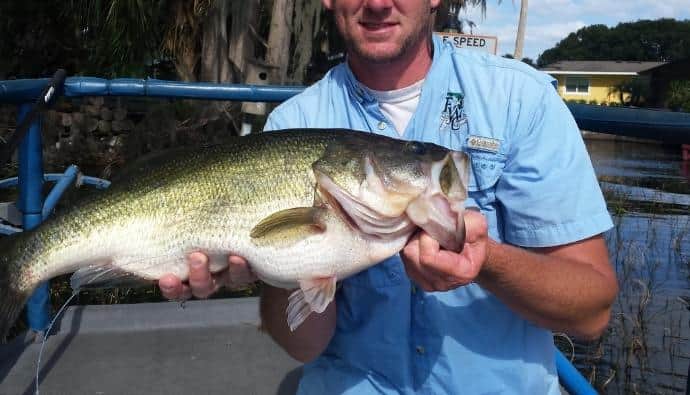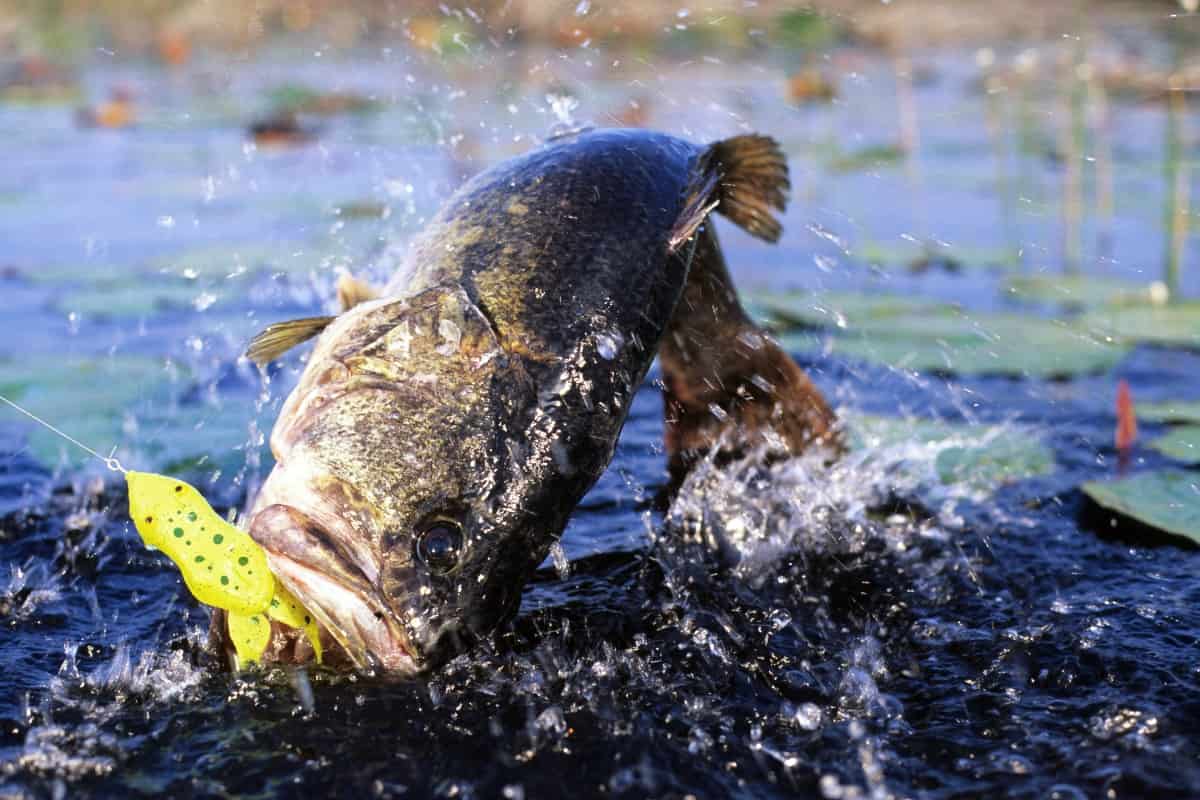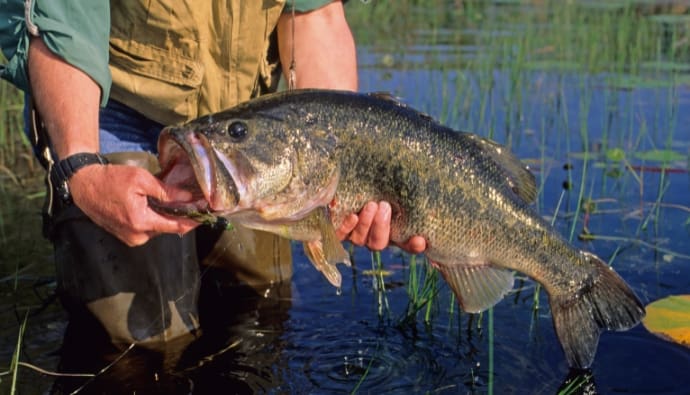Learning how to hold a bass is an essential part of bass fishing.
Many anglers know how to reel in striped, largemouth, and smallmouth bass. But the problem comes when they land it because they don’t know what to do next.
Knowing how to hold a bass correctly makes fishing safe, relaxing, rewarding, and enjoyable. Holding a bass seems easy, but it requires a lot of attention. In catch-and-release bass fishing, an improperly held fish will likely die soon after putting it back in the water.
So, how do you hold your bass? This guide will show you the correct and safest way to correctly hold a bass while fishing.

Tips on How to Hold and Handle a Bass
As a fishing enthusiast, there are a few things you need to consider when you hold a bass:
- How you place your hands
- Where you position your thumb and the rest of your fingers
- The type of hold to do
- The body weight of the bass (is it possible to grab its bottom lip?)
- Bass teeth
Holding a bass at an angle greater than 10 degrees creates too much pressure on its jaw. As a result, the jaw can dislocate, limiting the fish’s ability to hunt and eat prey.
Below are three ways to hold your catch when bass fishing:
1. Vertical Hold
Many anglers can testify that holding the bass vertically is the safest and best way to handle a fish. For this method, you’ll need to put your thumb inside the bass mouth on the bottom lip. Then, place the rest of your fingers underneath the lip, outside the mouth.
Its face will face the sky while its tail will point downwards. This position helps to relieve any pressure on the bass’ jaw.
However, ensure that you keep a firm grip on the underneath lip so the fish does not slip away. At the same time, be careful not to bend the jaw backward too much to avoid damaging the bass’s body.
When holding the bass in a vertical position, the key areas you protect are their jaw and slime coat.
The body of a fish has a slime coat, also known as the mucoprotein barrier. This coat forms part of the fish’s immune system and helps to keep away infections and diseases. Handling the bass too much with your hands may remove some of that coating.
Also, laying the fish on sand or grass can cause it to lose its coating. What I love most about the vertical hold is that it does not require you to touch anywhere else apart from the lip.
Be careful when making an angled hold, whether on a smaller fish or larger fish. Try as much as possible to keep the fish straight up and down. This is because tilting the fish could cause serious damage to the lower lip and teeth.
2. Horizontal Hold
You may want to take a trophy picture when you catch large bass. In this case, holding the fish in a horizontal position is preferable.
Many anglers love the horizontal hold as it provides more support and distributes the fish’s weight evenly across the body.
You use the same grip technique as used for a vertical method. Just hold your fish in a vertical position, put your thumb in its mouth, and then grab the lower lip.
Put your other hand directly underneath the fish’s body towards the tail behind the anal fin. Doing so allows you to support the weight of its body.
You don’t need a very firm grip for a horizontal hold. Better still, you can hold a bass of any weight or size without causing stress to the fish’s jaw.
3. Angled Hold
If you are considering using an angle hold, you should know it’s not the best option.
This method involves holding the bass at an angle greater than 10 degrees. In the process, you put all the pressure on the fish’s jaw, on the bottom lip. As a result, the fish cannot close their mouth properly, affecting the way they hunt and feed.
Angled bass holding is unhealthy, more so to larger bass, and could cause permanent damage to their body. But small bass is a bit safer when held at an angle and may not put a lot of strain on your grip.
Unfortunately, this hold is famous in photos displayed by renowned anglers and fishing platforms.
Do Bass Have Teeth?
Before putting your fingers in or near its mouth, it would be good to ask yourself, do bass have teeth?
The thumb-in-mouth is a popular approach when holding a bass horizontally or vertically. Before practicing it, remember that bass have teeth, and they are pretty sharp. However, you may not see them.
Unlike sharks and other big fish, the bass does not have a powerful jaw. But their needle-like, small teeth can easily break skin if you are not careful.
Bass teeth are predominantly for snatching up prey before pushing and killing it in their throats. Although bass teeth cannot do real damage, they are excellent at keeping a solid grip on prey.
Tip: Any time you go bass fishing, carry a fish grab tool. It comes in handy when handling largemouth bass and striped bass since putting your bare hand in their mouth can be dangerous.
How to Avoid Bass Thumb
The best way to avoid bass thumb is by not inserting your thumb too far into the fish’s mouth when lipping it. You only need to get your thumb over its lip and slightly into its mouth.
You should also be calm and composed throughout the process of lipping bass. Sometimes, the fish will struggle hard to free itself. This situation can cause your adrenaline rush but try your best to maintain control.
Remember to use both hands to handle the fish, especially when lifting the bass.
How to Unhook a Bass
The process of unhooking a bass is similar to general fishing.
Start by reeling your catch in until you can grab it with your hand. Then, firmly grab the fish’s underside and carefully slide the hook out of its mouth.
When unhooking a bass, here are some of the things you should keep in mind:
- Never squeeze the body of a fish when holding it. A bass has very delicate internal organs. Placing your thumb or fingers wrongly with too much pressure can kill it.
- Avoid messing with the gill plate at all costs. Any slight interference could damage the fish’s respiratory system.
- When doing catch and release, toss the fish back in the water head first.
Related Questions
The safest way to hold a bass is either vertically or horizontally. This way, you will not pressurize or break its jaws.
A vertical hold by the lower lip is ideal for many bass, especially for the smaller ones. But if you are handling a big bass exceeding 3 pounds, consider a horizontal hold.
A bass’s teeth are sharp and can hurt you during lipping if you put your thumb too far into its mouth. To avoid getting a bass thumb, always handle the fish with care.
The hook does not cause significant harm to the fish. However, not holding the jaw correctly can distort or break it, causing long-term damage to the fish.
Conclusion
Now that you know how to hold a bass properly, you can be sure to enjoy your next fishing trip.
Every successful bass fishing entails handling fish correctly without hurting them or causing undue pressure on their jaw.
Whether your catch is a small or big bass, remember to keep a firm grip on the lower jaws. And support the body with your other hand to distribute weight evenly.



 Facebook
Facebook YouTube
YouTube









